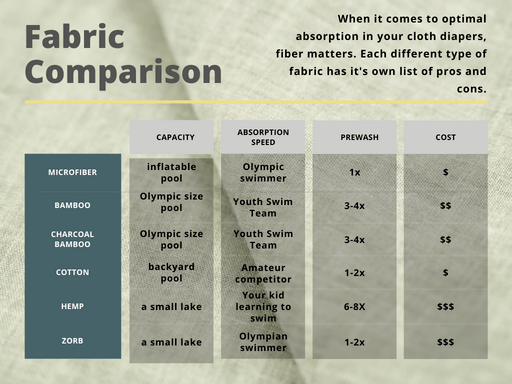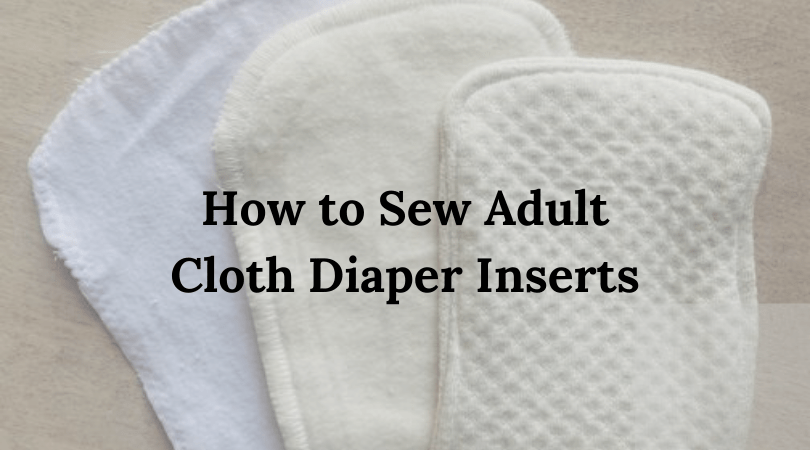Sewing your own inserts for your washable adult and big kid cloth diapers and pull ups is a great way to add extra absorbency without increasing drying time. Plus, sewing your own is cheap AND you can get exactly what you want. In this article, you will learn what material is best for cloth diaper inserts and how to make a diaper insert at home.

Want a template?
Get your FREE Adult Cloth Diaper Insert Pattern here! It comes in 3 sizes.
What Fabric to Use
While you can buy fabrics from one of many awesome places, you can also use what you have around the house. Flannel, particularly, can be found in many things from sheets to clothing. The only fabric I would advise against using would be bath toweling. This is because bath toweling is not only thick, but it sheds like crazy and is messy to sew with. Also, as far as absorbency vs. bulk goes, bath toweling falls in the low range.
However, if you are keen on finding fabrics around the house to use, go with things that have close to a 100% cotton or other natural fiber content.

How to Sew Inserts for Adult Cloth Diapers
In the videos below, I will walk you through 3 different methods to sew inserts, including turning and topstitching, zig zag, and serging.
In addition, I demonstrate each of these methods on 3 different fabric types. I do this because each fabric type reacts differently to each stitching method due to stretch and thickness of the fabric.
If you’re interested in learning more about how inserts work, please see my blog post on using inserts.
Part 1: Intro and Turn and Topstitch Method
The turn and topstitch method results in the cleanest finish of all the methods. It works best for woven fabrics like cotton flannel or for fabrics with minimal stretch. However, the thicker your fabric, the fewer layers you will be able to use since the edges tend to get really bulky.
Part 2: Zigzag Method
If you don’t care about looks and just want something functional, the zigzag method takes less time then turning and topstitching. It also enables you to sew together more layers than in the turn and topstitch method since you don’t have to worry about bulky edges.
If using stretchy fabrics, it’s extra important not to pull the insert through the machine as you sew it. Let the feed dogs do their job. Pulling the insert as you sew it will result in wavy seams. Now, for really stretchy fabrics, some wave is unavoidable, but if you pull it, it gets really wonky.
Part 3: Serging
Serging is amazing, but I confess that I’m biased. Although threading those dang things is almost enough to demote its awesomeness.
Anyway.
Serging results in a professional finish in the ease and time of using a zigzag stitch. If you have a serger and have spent more time staring at it than actually using it, inserts are a great introductory project to try. Just take your time, go slow around the corners and before you know it, you’ll be getting the hang of it.
For stretchy fabrics, use differential feed. If you don’t have a differential feed on your serger, take notes from the zigzag sections. It’s especially important not to pull the insert through the machine as it gets stitched. Otherwise you’ll end up with wavy edges.
And that’s it! Easier than pie. Just take your time and use the right settings for the fabric type and soon you’ll have a stash of inserts to make your cloth diapering experience even better.
If you have any questions, comment below or send me an email at hello@littleonioncloth.com.
If you’d like to learn how to sew super soft and absorbent cloth diapers for yourself or someone you love and care for, I will help you every step of the way! Just sign up for my VIP Pattern Waitlist to receive free tutorials and exclusive discounts on a variety of upcoming patterns for older children and adults. And if you haven’t already, you can also download your free adult/big kid cloth diaper insert pattern and access our sewing free tutorial.
Related articles:
7 Reasons Why You Should Sew Your Own Adult Reusable Diapers and Leakproof Underwear
21 Baby Inserts for Adult Cloth Diapers
How to Find Your Size and Check Fit for Incontinence Products
8 Best Youth Pocket and AIO Diapers for 2022
8 Best Adult Pocket and AIO Diapers for 2022
Related terms for this article: how to sew diaper inserts, making cloth diaper inserts, cloth diaper inserts diy, sewing cloth diaper inserts, adult cloth diaper insert diy, how to make diaper inserts at home, diy cloth diaper doublers, diy adult diaper inserts, diy adult diaper soakers, diy absorbent inserts, making cloth diaper inserts, adult diaper insert pattern, cloth insert pattern, quick diaper insert pattern, free diaper insert sewing pattern, free diaper sewing pattern for adult, free diaper soaker pattern, cloth diaper insert tutorial, easy sewing pattern for cloth diaper insert, adult diaper insert sewing pattern
Alecia
Latest posts by Alecia (see all)
- Why Little Onion is Not ABDL - November 1, 2024
- Best Adult Diaper Covers - March 7, 2024
- Best Fabrics for Making Adult Diaper Covers - February 16, 2024


